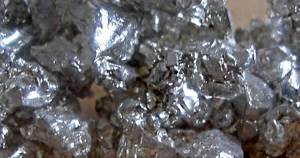The chemical element calcium is classed as an alkali earth metal. It was discovered in 1808 by Sir Humphry Davy.

Data Zone
| Classification: | Calcium is an alkali earth metal |
| Color: | silvery-gray |
| Atomic weight: | 40.078 |
| State: | solid |
| Melting point: | 842 oC, 1115 K |
| Boiling point: | 1484 oC , 1771 K |
| Electrons: | 20 |
| Protons: | 20 |
| Neutrons in most abundant isotope: | 20 |
| Electron shells: | 2,8,8,2 |
| Electron configuration: | 1s2 2s2 2p6 3s2 3p6 4s2 |
| Density @ 20oC: | 1.55 g/cm3 |
Compounds, Radii, Conductivities
| Atomic volume: | 29.9 cm3/mol |
| Structure: | ccp: cubic close packed |
| Hardness: | 1.75 mohs |
| Specific heat capacity | 0.63 J g-1 K-1 |
| Heat of fusion | 8.54 kJ mol-1 |
| Heat of atomization | 178 kJ mol-1 |
| Heat of vaporization | 153.6 kJ mol-1 |
| 1st ionization energy | 589.8 kJ mol-1 |
| 2nd ionization energy | 1145.4 kJ mol-1 |
| 3rd ionization energy | 4911.8 kJ mol-1 |
| Electron affinity | 2 kJ mol-1 |
| Minimum oxidation number | 0 |
| Min. common oxidation no. | 0 |
| Maximum oxidation number | 2 |
| Max. common oxidation no. | 2 |
| Electronegativity (Pauling Scale) | 1 |
| Polarizability volume | 22.8 Å3 |
| Reaction with air | vigorous, ⇒ CaO, Ca3N2 |
| Reaction with 15 M HNO3 | vigorous, ⇒ H2, Ca(NO3)2 |
| Reaction with 6 M HCl | vigorous, ⇒ H2, CaCl2 |
| Reaction with 6 M NaOH | none |
| Oxide(s) | CaO |
| Hydride(s) | CaH2 |
| Chloride(s) | CaCl2 |
| Atomic radius | 180 pm |
| Ionic radius (1+ ion) | – |
| Ionic radius (2+ ion) | 114 pm |
| Ionic radius (3+ ion) | – |
| Ionic radius (1- ion) | – |
| Ionic radius (2- ion) | – |
| Ionic radius (3- ion) | – |
| Thermal conductivity | 201 W m-1 K-1 |
| Electrical conductivity | 31.3 x 106 S m-1 |
| Freezing/Melting point: | 842 oC, 1115 K |

Calcium metal stored under an argon atmosphere. Image by Matthias Zepper

Rome’s Colosseum, resisting the ravages of time (okay, there are one or two missing pieces…) with the aid of calcium oxide based cement. Photo: David Iliff.

Stalactites – Mainly Calcium Carbonate.
Discovery of Calcium
People have used calcium’s compounds for thousands of years – in cement, for example.
Limestone [calcium carbonate] was called calx by the Romans. The Romans heated calx, driving off carbon dioxide to leave calcium oxide. To make cement, all you have to do is mix calcium oxide with water. The Romans built vast amphitheaters and aqueducts using calcium oxide cement to bond stones together. (1)
Despite the long history of calcium’s compounds, the element itself was not discovered until electricity was available for use in experiments.
Calcium was first isolated by Sir Humphry Davy in 1808 in London. In a lecture to the Royal Society in June 1808, Davy described his experiments that year, which produced tiny amounts of metal, at best. He could not find any way to produce more calcium metal until a letter from Jöns Berzelius in Stockholm pointed him in the right direction. (3)
Davy learned that Berzelius and Magnus Pontin had used a battery to decompose calcium oxide at a mercury electrode and they had obtained an amalgam of mercury and calcium. (Berzelius, the great Swedish chemist, exchanged a great deal of information with Davy. Berzelius had earlier learned from Davy that potassium could be dissolved in mercury to form an amalgam. Berzelius had extended the method.) (3),(4)
Davy made a paste of slaked lime [calcium oxide, slightly moistened to form calcium hydroxide] and red oxide of mercury [mercury (II) oxide]. (3)
He made a depression in the paste and placed about 3.5 grams of mercury metal there to act as an electrode. Platinum was used as the counter electrode. Davy carried out the experiment under naptha (a liquid hydrocarbon under which he had found he could safely store potassium and sodium).
When electricity was passed through the paste, a calcium-mercury amalgam formed at the mercury electrode.
Davy removed the mercury by distillation to reveal a new element: calcium.
Davy used the same procedure to isolate strontium, barium, and magnesium.
He named the metal calcium because of its occurrence in calx.
Interesting Facts about Calcium
- Calcium is the most abundant of the metallic elements in the human body. The average adult body contains about 1 kg or 2 lb of calcium, 99% of which is in the bones and teeth. Only oxygen, carbon, hydrogen and nitrogen are more abundant in our bodies than calcium.
- Calcium not only builds the structures that support our bodies, many of us also live in homes built using structural concrete or cement made with lime (calcium oxide). Snails and many shellfish use another calcium compound – calcium carbonate – to build their own homes too – their shells.
- Modern humans were not the first people to make use of calcium to build things. Egypt’s pyramids were built using limestone blocks. Limestone is crystalline calcium carbonate. In the later pyramids, the blocks were held together with gypsum or lime based mortar. Gypsum is calcium sulfate dihydrate and lime is calcium oxide.
- Have you ever wanted to be ‘in the limelight?’ Lime is calcium oxide, which produces a brilliant, intense light when burnt in an oxyhydrogen flame. It was used to light the stage in theaters during the 1800s until electricity took over – hence the saying.
- Cells in animals and plants must communicate with other cells. This is called signaling. Calcium ions are the most important messengers between cells in living things and are absolutely vital for the existence of multicellular life forms.

Appearance and Characteristics
Harmful effects:
Non-toxic and an essential metal for living organisms.
Characteristics:
Calcium is reactive and, for a metal, soft. With a bit of effort, it can be cut with a sharp knife.
In contact with air, calcium develops a mixed oxide and nitride coating, which protects it from further corrosion.
Calcium reacts easily with water and acids and the metal burns brightly in air, forming mainly the nitride.
Uses of Calcium
Calcium forms alloys with aluminum, beryllium, copper, lead, and magnesium.
It is used in the manufacture of other metals such as uranium and thorium.
Calcium is used to remove oxygen, sulfur and carbon from alloys.
Calcium from limestone is a vital component of Portland cement.
Quicklime (CaO) is used in many applications in the chemical industry, such as treatment of drinking water – especially for water softening and arsenic removal, animal waste and wastewater.
Abundance and Isotopes
Abundance earth’s crust: 4.2 % by weight, 2.2 % by moles
Abundance solar system: 70 parts per million by weight, 2 parts per million by moles
Cost, pure: $20 per 100g
Cost, bulk: $ per 100g
Source: Calcium occurs in nature in various minerals including limestone (calcium carbonate), gypsum (calcium sulfate) and fluorite (calcium fluoride). Commercially it can be made by the electrolysis of molten calcium chloride, CaCl2. The pure metal can also be produced by replacing the calcium in lime (CaCO3) with aluminum in hot, low pressure retorts.
Isotopes: Calcium has 19 Isotopes whose half-lives are known, with mass numbers 35 to 53. Naturally occurring calcium is a mixture of six isotopes and they are found in the percentages shown: 40Ca (97%), 42Ca (0.6%), 43Ca (0.1%), 44Ca (2%), 46Ca (0.004%) and 48Ca (0.2%).

References
- The Secrets of Roman Concrete (pdf download)
- John Davy, Memoirs of The Life of Sir Humphry Davy., Vol 1, 1836, p395, Longman.
- John Davy (Editor), The Collected Works of Sir Humphry Davy, Vol V, 1840, p111 Smith, Elder and Co. Cornhill.
- Jaime Wisniak, Jöns Jacob Berzelius A Guide to the Perplexed Chemist., Chem. Educator, 2000, 5, p343-350.
Cite this Page
For online linking, please copy and paste one of the following:
<a href="https://www.chemicool.com/elements/calcium.html">Calcium</a>
or
<a href="https://www.chemicool.com/elements/calcium.html">Calcium Element Facts</a>
To cite this page in an academic document, please use the following MLA compliant citation:
"Calcium." Chemicool Periodic Table. Chemicool.com. 04 Oct. 2012. Web. <https://www.chemicool.com/elements/calcium.html>.
How much does calcium cost? Please answer.
Thanks,
Shea
If you scroll up the page a little you’ll see… Cost, pure: $20 per 100g 🙂
Where can it be purchased?
what is the difference between calcium that is found in our milk and calcium the metal?
Hi Carter, Calcium metal is made up of calcium atoms. The calcium in milk consists of calcium ions.
What is calcium most commonly used for?
Hi Marie, Metallic calcium’s most common use is in steel manufacturing. Calcium reacts or joins with impurities in molten steel during the manufacturing process, which allows the impurities to be easily removed.
Calcium also makes up a great percentage of our body because it makes up our bones and teeth.
Does it have an odor?
No, calcium has no smell.
I was wondering… What is Calcium’s weakness? You know like, The things calcium has to stay away from.. to prevent any poison or toxic stuff
What 3 elements along with calcium do you think would be like the Fantastic Four i.e.. to make a 4-element superhero team? Thanks.
Hmm. Since the fantastic four are fictional characters, you’re looking for fictional elements. How about elements 113, 115, 117 and 118 — ununtrium, ununpentium, ununseptium and ununoctium. IUPAC doesn’t think they exist. 😉
What 2 physical and chemical properties does calcium have?
Look at the Data Zone. You’ll find lots of properties. Melting point, boiling point, density are examples of physical properties. The reactions calcium takes parts in are examples of its chemical properties.
About how much is in the biosphere, lithosphere, atmosphere, and hydrosphere in percentages?
What is the conductivity ????? And the flammability